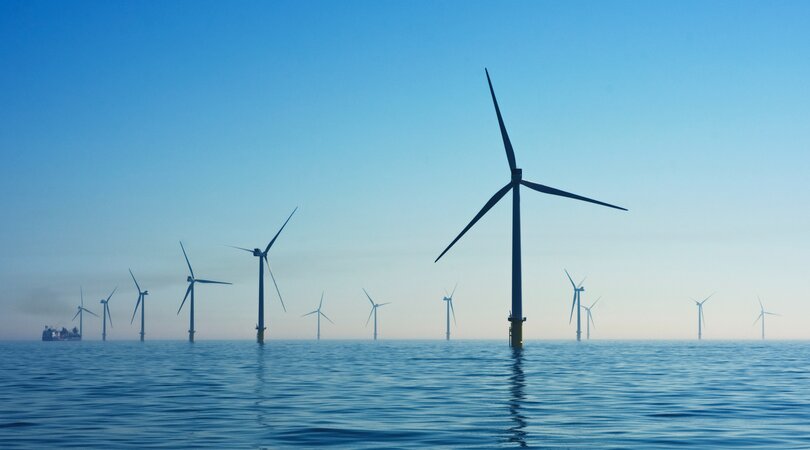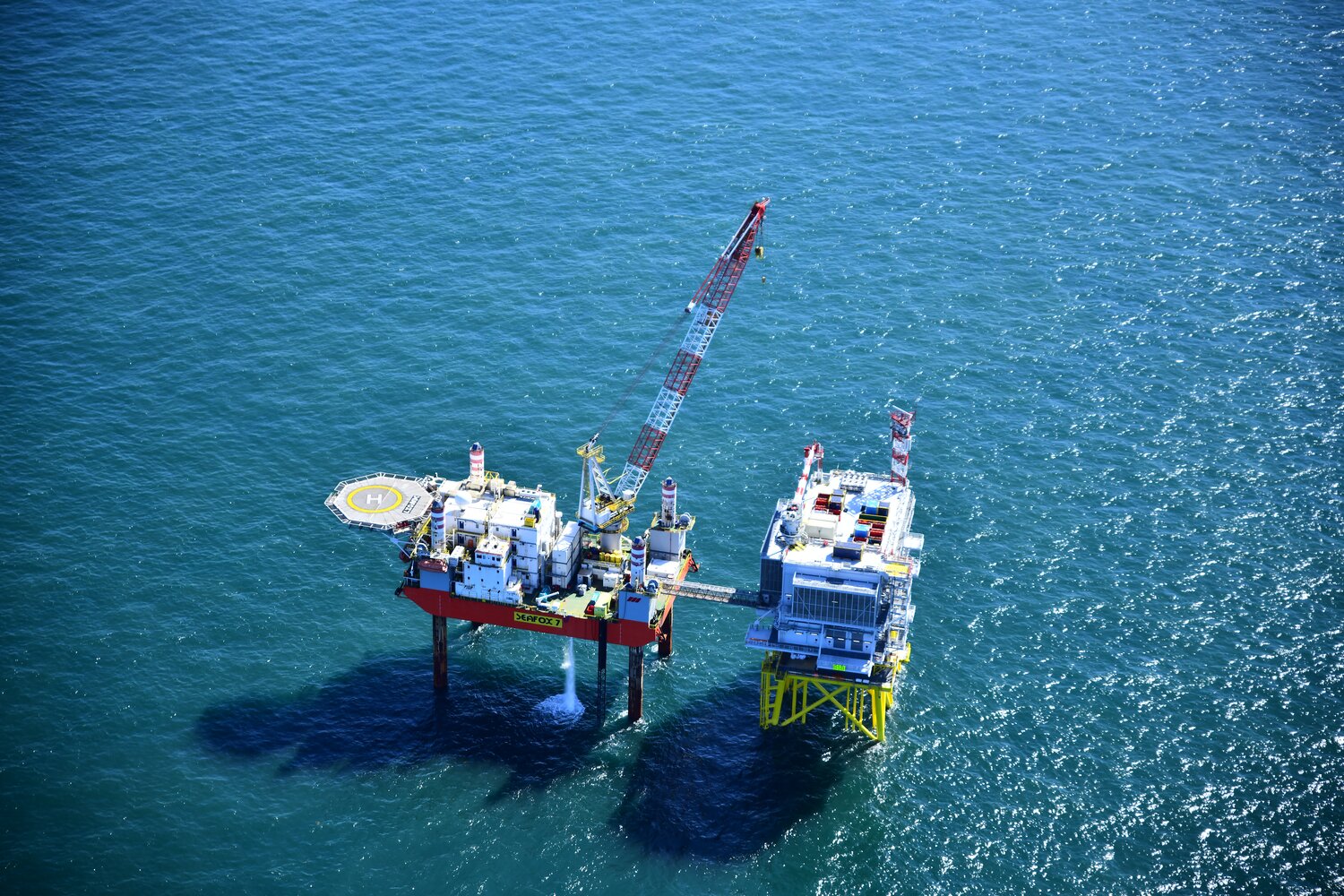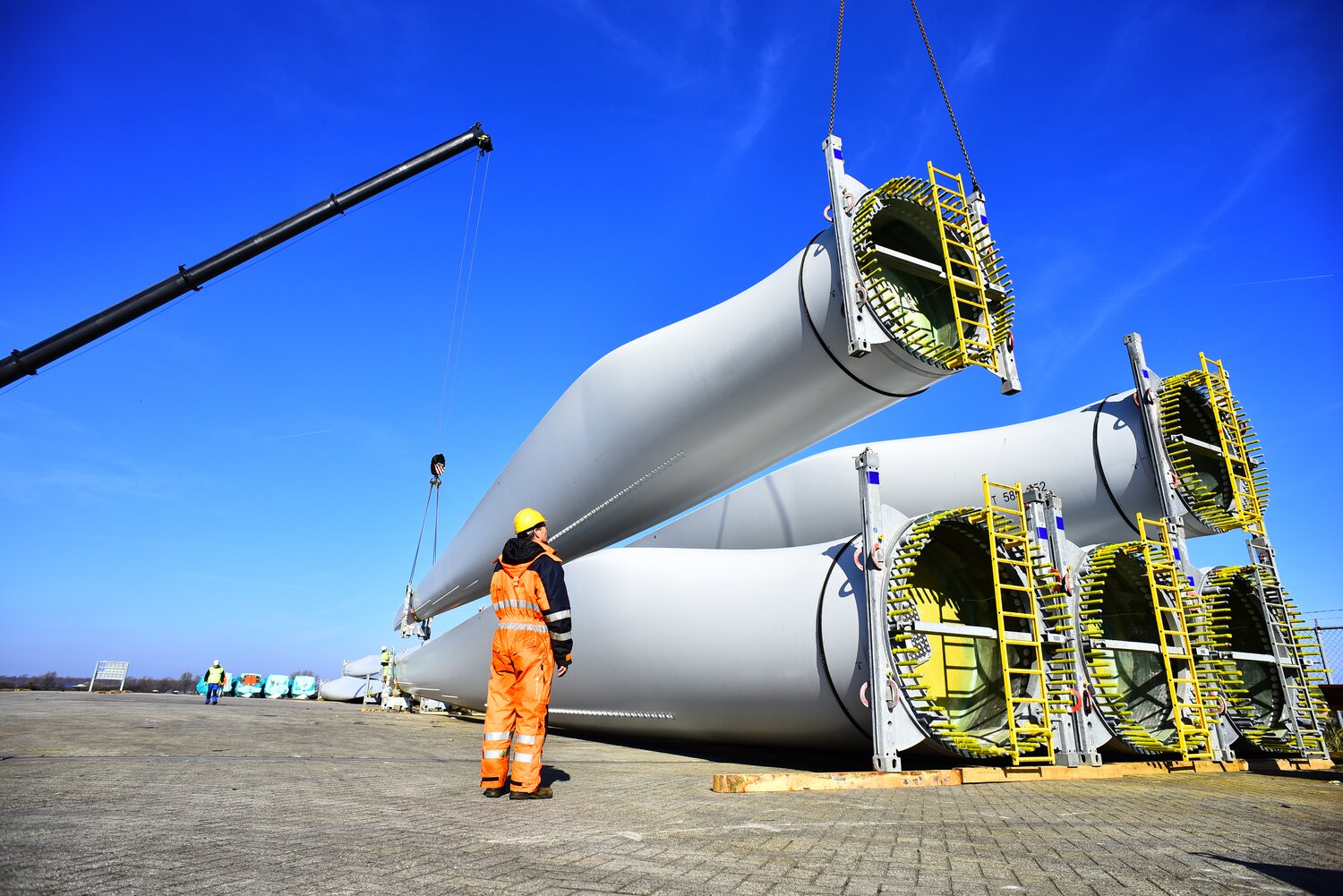Our new NorthStandard site is now live. There will be no new content or updates added to this site. For the latest information, please visit our new site north-standard.com.
洋上風力発電を促進する変わりゆく世界
風力発電を多くの戦略の重要な部分として、国内外当局が脱炭素化計画を進めているため、再生可能エネルギーの推進は時代の風潮です。

経済の多様化、新型コロナウイルス関連の混乱、ロシアとウクライナの紛争に続く輸入ガスへの依存を減らしたいという願望により、再生可能エネルギーへの転換が加速しています。
洋上風力発電エネルギーは、エネルギーミックスの中で急速に成長している部分です。しかし、これには独自の課題があります。海事部門は、このような変化する要求を満たす準備ができているのでしょうか?移行を支援するためのリソースとインフラストラクチャは利用可能でしょうか? 今後、業界はどのように組織化されていくのでしょうか?
スタンダードクラブの『Alongside』ポッドキャストで、この分野の専門家2人が、洋上風力発電プロジェクト開発支援における各々の企業関与について話しました。
支払う価値のある価格なのでしょうか?
洋上風力発電市場への世界的な浚渫請負業者および海洋サービスプロバイダーBoskalisの公認土木技術者および商業マネージャーであるStuart Keeble氏は、再生可能ロジスティクスが近年どのように劇的な変化を遂げたかを概説しました。
「インフレ環境も価格を高騰させ、価格とプロセスのより広範囲な調整につながっている」とKeeble氏は語っています。
当初ロシアや他国に向かっていた船舶は、別の仕事や目的に転用しなければならなかったとも付け加えています。
世界中の石油、ガス、風力、土木工学プロジェクトの杭打ち技術とサービスを専門とするドイツ拠点のMenckのマネージングディレクターであるFabian Hippe氏も、同様の問題に直面しています。
鉄鉱石などの重要な原材料の最大の生産国の1つであるウクライナは、決定的な工具の生産に問題を抱えていました。鋼材の原材料はMenck製品の主要な要素であり、紛争により価格が高騰しています。
BoskalisとMenckはどちらも洋上風力発電設備工程のさまざまな側面に関与しており、しばしば一体となって働きます。一方の会社は物流支援を提供し、もう一方の会社は風車を地面に打ち込む設備を提供します。
2人の専門家は、生産段階でも費用がかかるようになっていると『Alongside』で語っています。インフレにより生産時間が増加し、サプライヤーに圧力がかかっています。
「ハンマーの生産について話し合っている間に、12か月は簡単に過ぎていきます。現在では、18から24か月を予定しています」とKeeble氏は述べています。
これらの問題全ては、投資家が機器を求め、支出の迅速な回収を求めている中で発生しています。これらの相殺する圧力をお互いに打ち消し合うことが、現在、海事産業のサービスプロバイダーと部品サプライヤーにとって主要な関心事です。
変化の風
供給問題と物価高騰の中で、オフショアエネルギー源への急激な転換が世界中で起こっています。
「ここ英国には、過去15年から20 年近くにわたり開発されてきた膨大な風力資源があります」とKeeble氏は話します。
他の市場も後に続き、欧州は中国の投資により再生可能技術の価格の押し下げを受けている世界的リーダーとなっています。同様に、日本と米国は洋上風力発電資産で著しい進展を遂げています。
Keeble氏によると、これは投資機会にとっては良い兆候ですが、論理的には大きな難問を差し出しています。
世界中の風力発電プロジェクトを支援するために帆船を運航し、数年後に予定されている設置の準備を行うことは、パンデミック後の状況とヨーロッパでの戦争を考慮すると重要な課題です。
「もし完璧な世界というものが存在するならば、1つの船舶グループが1つの地域にとどまり、風力発電所を建設するべきだと主張するかもしれません。しかし現実には、そんなうまい具合には機能しません」とKeeble氏は言います。
規模の変化も要因です。風力発電所は巨大なプロジェクトであり、持続可能なエネルギーの需要が高まるにつれ、規模も需要に応じて追随します。
これは、着床式風力プロジェクトだけに該当するわけではありません。業界内の技術革新が進むにつれ、深海への曳航を含む真新しい操作を必要とする浮体式洋上風力発電は、やがて従来の風力発電の「輝きを失わせる」だろう、とKeeble氏は述べています。
Menckのスケジュールに関する限り、現在、2024年の風力発電設置プロジェクトは全部予約で埋まっています。また、2025年とその翌年に向けてプロジェクトを進めており、新しい設備構築のためのリードタイムは約2年です。
MenckとBoskaalisが取り組んでいるプロジェクトの1つは、米国のブロック島の拡張です。2015年に5基の風力タービンが導入され、現在3か所の風力発電所が建設される予定です。これは、世界中で行われている一種の活動を示しています。
「私たちは台湾で取り組んでいます。私たちは今日までヨーロッパで世界最大の風力発電所に取り組んでおり、これは3か所の異なる発電所で構成される非常に大規模な開発であり、発電所ごとに95本のモノパイル式基礎を設置する必要があります」とHippe氏は説明しました。
世界的な展開と相互のつながり
現在、発展途上国が再生可能エネルギーへ大きな関心を表明しています。海岸沿いや 実用になるほどの風力発電量がある場所であればほぼどこでも風力エネルギーの候補地です。発展途上国は、脱炭素化し、より多くの万能なエネルギー源を生み出すという圧力に直面しています。
「今の段階では、南半球は北半球に比べて非常に未熟ですが、それが再び世界のサプライチェーンに異なる需要と異なる原動力をもたらします」とHippe氏は語ります。
最初から、開発途上国は最大の風力発電所の設置を頼みにしていませんが、他の拡張の必要性は、Boskalisが提供する船舶やMenckが提供する杭打ち設置機器などの極めて重要な製品の需要に拍車をかけます。
このような世界規模で作業する際に発生する問題は、現在さまざまな国の地域サプライチェーンが十分に現地支援を提供できないことにある、とHippe氏は説明しています。
「ヨーロッパの請負業者が、1か所の発電所を設置するためだけに常に米国に出航し、その後船で帰国することは持続可能ではありません。それはかなり非生産です」とHippe氏は述べています。
さまざまな発電所の相互のつながりの性質は、設置に関して言えば、国際的な展開と同じくらい重要です。
エンジニアリング部品サプライヤーとロジスティクスの両者が互いに協力して機能します。Keeble氏によると、風力発電所の部品を海岸から海まで運ぶ船舶は、構造物の設置に必要なハンマーがなければ「単なるタクシーに過ぎない」のです。
こういうわけで相互依存関係が不可欠なのです。ある発電所の責任が他の発電所にどのように必然的に影響するかを理解することは、国際的な再生可能エネルギーの目標を達成する上で中核を成します。
「企業は急いで規模を拡大し、可能な限り多くその成長を取り込もうとすることができます。しかし、成し遂げられない場合、このような潜在的な失敗という将棋倒し効果に最後陥ります」とKeeble氏は付け加えました。
サプライチェーンの課題
米国とヨーロッパのキャパシティの決定的な違いは、北米が石油とガスの資産において歴史的にリードしていることが、洋上風力発電プロジェクトに必要なインフラストラクチャに相殺される影響を与えたことです。特注のテクノロジー、プラットフォーム、船舶は、全く十分な量ではありません、とHippe氏は説明します。
これにより、米国プロジェクトは、風力発電所を設置するために大西洋横断航海を行うヨーロッパ請負業者に部分的に依存するというエキサイティングな立場に置かれます。
「現在、私たちは資源や港湾施設を活用するために、利用可能な石油とガスのインフラストラクチャがほとんど存在していない地域に進出しています」とHippe氏は語ります。「このような場所には、米国東海岸など、人口の大部分が住んでいる地域が含まれます。電気を長距離輸送するよりも、人々が住む場所で風力開発する方が常に有利です」
人間レベルでは、洋上風力発電所の拡大は、労働者組織の刷新が既に遅れている可能性があります。風力発電所プロジェクトは完成するまでに何ヶ月もかかる場合があり、世界中でより多くの作業が行われているということは、自宅を離れて何週間もプロジェクトの支援のために海上で滞在する労働者が増えていることを意味します。
「実際には、それに関してさまざまなモデルに対応できます。従業員に柔軟性を与えることで、開発に向けて掲げられた野心の点において私たちは前進することができます」とHippe氏は述べています。
鋼材、ケーブル生産、船舶の利用可能性に関するさらなる懸念を含んだ課題があるにもかかわらず、Keeble氏は、世界中のパイプラインのほとんどのプロジェクトが完了できると相変わらず楽観的です。法的枠組みや規制の枠組みに関する計画もハードルになる可能性がありますが、連携の強化と国際的な結束によって効果的に対処できると彼は信じています。
「風力発電所の建設は、実際には設置のずっと前から始まっています」とKeeble氏は説明します。「現在、風力発電所開発には、着想から完成までに 優に10年以上かかることがあります。実際、膨大な量のエンジニアリング、計画、法的な資金調達が関わってきます。そして、これらは、とりわけ英国に確実に備わっている強みです」
国際協力は、設置プロジェクトに関与する各当事者に全体的な目標を提供するだけでなく、国際的な技能移転を促進します。初期段階で風力エネルギーを開発している国に住んでいる人は、ヨーロッパ、米国、英国に赴いて、本質的なエンジニアリングの専門知識を学び、身に付けて帰国することができます。はるか遠くからの強風が多くのタービンを動かすことができるように、世界のある場所で起こる進歩が他の場所に機会を提供します。
新しく発行された16ページあるスタンダードクラブ オフショア&再生可能保険契約ガイド が閲覧可能になりました。
A price worth paying?
Stuart Keeble, a chartered civil engineer and the commercial manager at Boskalis, a leading global dredging contractor and marine services provider to the offshore energy market, outlined how renewable logistics has seen dramatic changes in recent years.
"The inflationary environment has also been driving prices up, leading to extensive price and process adjustments", Keeble said.
He added that vessels initially heading for Russia and other countries have had to be diverted to alternate works and purposes.
Fabian Hippe, Managing Director of Menck, a German-based specialist in pile-driving technology and services for oil and gas, wind and civil engineering projects worldwide, is experiencing similar issues.
Ukraine is one of the largest producers of essential materials, such as iron ore, which has been problematic for producing crucial tools. Raw steel is a primary element of Menck products, and the conflict has led to a price hike.
Both Boskalis and Menck are involved in different aspects of the offshore installation process and often work together. One company provides the logistical support, while the other supplies equipment driving windmills into the ground.
The two experts told Alongside that the production phase is becoming expensive too. Inflation has seen output time increase and put pressure on suppliers.
"While we are talking about production of a hammer, an excess of 12 months is easy. We're now looking rather at 18 to 24 months," Keeble said.
All of these problems are occurring amid a push from investors seeking equipment and prompt returns on their expenditures. Balancing these countervailing pressures is now a primary concern for service providers and component suppliers in the maritime industry.

Winds of change
Amid supply issues and skyrocketing prices, a radical shift towards offshore energy sources is happening around the world.
"Here in the UK, we have an enormous wind resource that's been developed over the last 15, nearly 20 years," Keeble said.
Other markets are now following suit, with Europe as a global leader with downward pressure on renewable technology prices due to Chinese investments. Likewise, Japan and the US are making significant progress in offshore assets.
While this bodes well for investment opportunities, logistically, it presents a huge puzzle, according to Keeble.
Sailing vessels to support wind farm projects worldwide, and making preparations for installations set to take place years in the future, is a significant challenge considering post-pandemic circumstances and a European war.
“In a perfect world, you might argue that one group of vessels should just stay in one region and build those wind farms. But the reality is, it doesn’t work like that,” Keeble said.
Changes in scale are also a factor. Wind farms are gigantic projects, and as the demand for sustainable energy grows, size follows suit.
This isn't just the case for fixed wind projects either. As innovation within the industry advances, floating wind farms, which require a whole new operation involving towing them into the deep ocean, will soon "eclipse" traditional windfarms, Keeble said.
As far as Menck's schedule is concerned, it is now fully booked in 2024 for wind farm installation projects. It is also taking projects into 2025 and the following year with a lead time for building new equipment of around two years.
One project Menck and Boskaalis are working on is the expansion of Block Island in the US. In 2015, five turbines were installed, and now three whole wind farms are to be constructed. This is indicative of the kind of activity taking place the world over.
"We're working in Taiwan; we're working in Europe, on the world's largest wind farm to this day, which is a very massive development consisting of three different farms with 95 monopiles and foundations to be installed per farm," Hippe explained.

Global reach and interconnectivity
A significant interest in renewables is now coming from the global south. Almost anywhere which has a coastline and available wind yield, is a candidate for wind energy. Developing countries are facing pressure to decarbonise and generate more sovereign energy sources.
"The Southern Hemisphere this time is very much immature compared to the north, but that again drives a different demand and different dynamics into the global supply chain," Hippe said.
Developing countries are not initially looking to install the largest wind farms, but other imperatives for expansion spur on demand for critical products like vessels, which Boskalis provides, or pile installation equipment, as Menck offers.
A problem that arises when working on such a global scale, Hippe explained, is that regional supply chains for different countries are currently inadequate for sufficient local support.
"It's not sustainable for European contractors to always sail to the US just to do one farm and then sail back home. It's rather counterproductive," Hippe said.
The interconnected nature of different firms is as important as their international reach when it comes to installation.
Both engineering component suppliers and logistics work in cooperation with each other. According to Keeble, a vessel that takes wind farm components from shore to sea is "really just a taxi" without the hammer needed to install the structure.
This is why mutually dependent relationships are essential. Understanding how the responsibility of one firm necessarily impacts the other will be central to meeting international renewable targets.
"Companies can rush to scale up and try to seize as much of that growth as possible. But if you fail to deliver, you end up with this kind of domino effect of potential failure," added Keeble.

Supply chain challenges
A major distinction between US and European capacity is that North America's historic lead in oil and gas assets has had a countervailing impact on the infrastructure necessary for offshore projects. The bespoke technology, platforms and vessels are simply not there in sufficient quantity, Hippe explained.
This puts US projects in the exciting position of partly relying on European contractors making transatlantic voyages to install wind farms.
"We're now going into areas that have hardly any oil and gas infrastructure available in order to tap into resources, port facilities as well," Hippe said. "This includes areas where the majority of the population lives, like the East Coast of the US. It's always favourable to develop wind where people live rather than transport electricity over a long distance."
At the human-level, offshore wind farm expansion may be overdue for a revamp in its labour organisation. Wind farm projects can take many months to complete, and more of them taking place worldwide means more workers staying at sea to support projects for weeks away from home.
"We can actually accommodate different models on that. Giving flexibility to the employees would give us a headway in terms of the ambition that has been set for developments," Hippe said.
Despite the challenges, including further concerns over steel, cable production and vessel availability, Keeble remains optimistic that most projects in the pipeline globally can be completed. Planning around legislative and regulatory frameworks can also be a hurdle, but he believes this could be effectively addressed through further cooperation and international cohesiveness.
"Constructing a wind farm actually starts way before installation," Keeble explained. "The development of a wind farm now can take easily a decade or more from conception to completion. That really involves a huge amount of engineering, planning, legal financing. And these are strengths, which the UK, in particular, has in spades."
Global cooperation doesn't just offer a holistic aim for every party involved in installation projects but also facilitates international transfers of skills. Those living in countries developing wind energy in its embryonic stages can travel to Europe, the US and the UK to learn essential engineering expertise and transport them home. Advancements in one part of the world offers opportunities elsewhere, like a strong wind from afar can move many turbines.
The newly published 16-page Standard Club Offshore & Renewables Contracting Guide is now available.
カテゴリー: Offshore & Renewables

